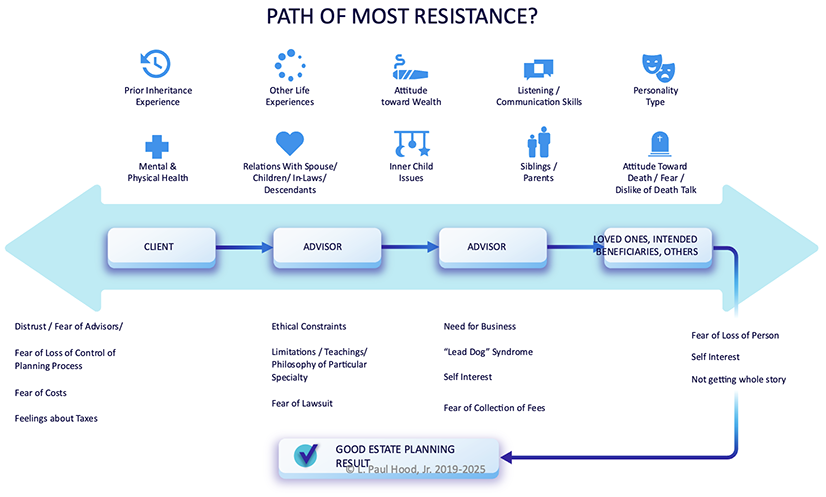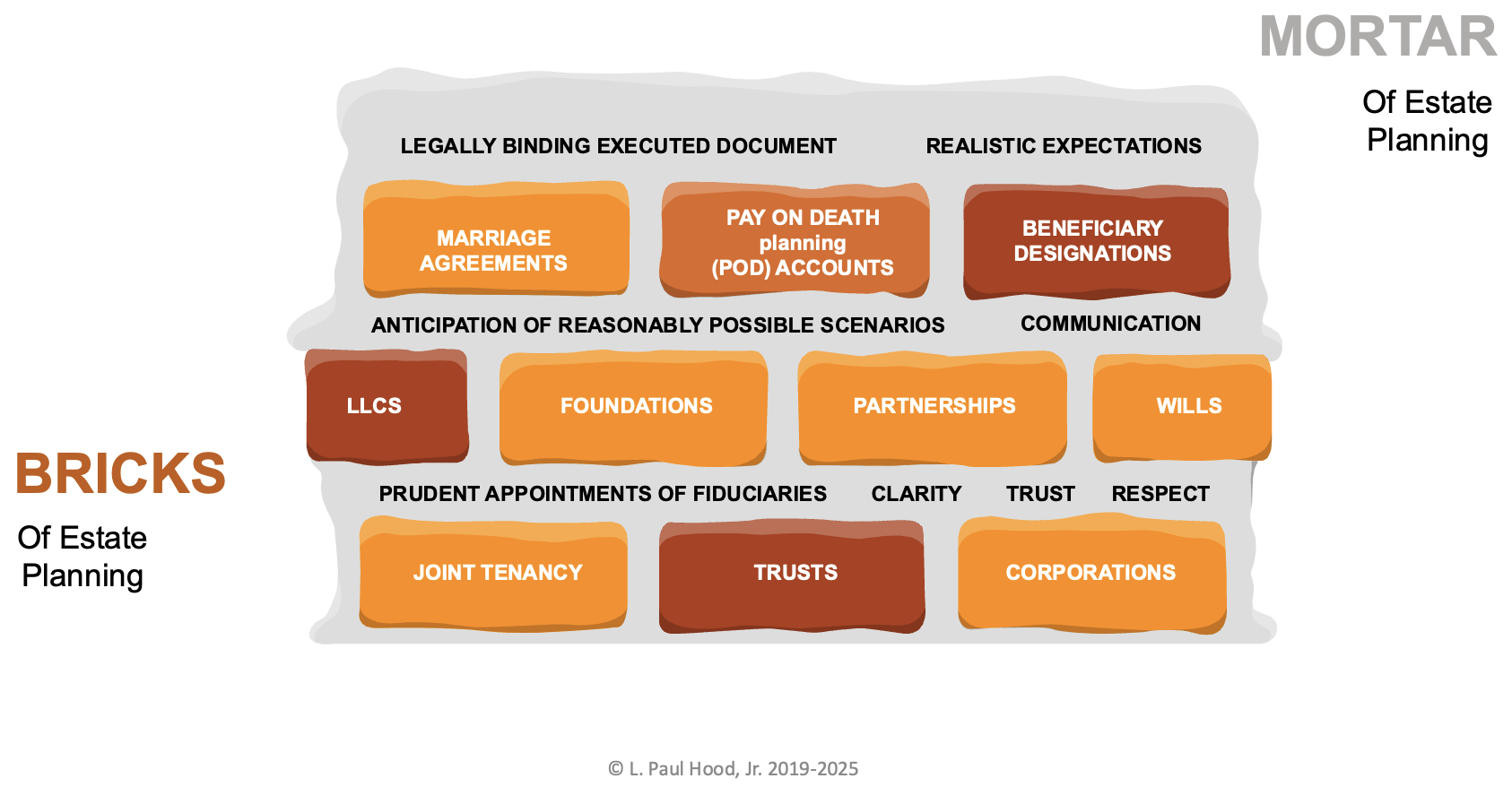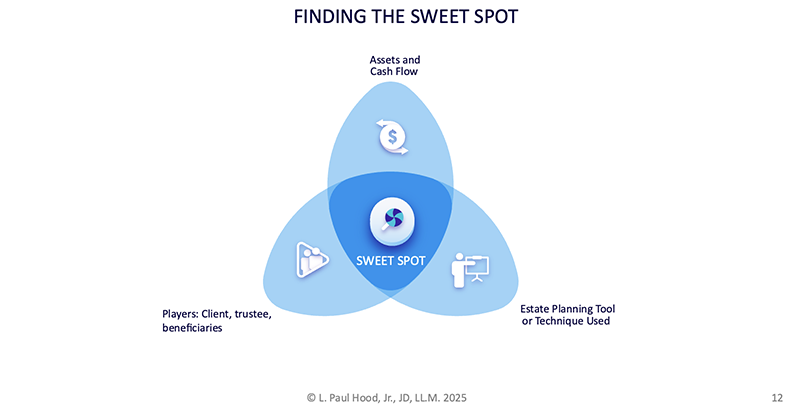NAEPC Webinars (See All):
Issue 47 – October, 2025
Three Estate Planning Pictures Worth Thousands of Words
By: L. Paul Hood, Jr., JD, LL.M., CFRE, FCEP
The identity of the person who first said “a picture is worth a thousand words” is unclear-the possibilities run from Confucius to Brisbane to others. However, what is crystal clear is its immutable truth. Indeed, a good picture is worth at least a thousand words.
Introduction
In this article, I present three good pictures, i.e., models that view estate planning from 30,000 feet and explain it in concept and theory. Possessing zero artistic skill, I then had a graphic design artist put each in graphic form. In this piece, I highlight purposeful planning wisdom from the models that I hope you will find useful in your estate planning work for clients and their families.
Picture 1: Path of Most Resistance©
What is your client’s ultimate goal in their estate planning? As my first graphic, entitled “Path of Most Resistance©” (“Path©”) shows, the ultimate goal of your estate planning work should be a “good estate planning result.” I define a “good estate planning result” as one where property is properly transmitted as desired, and family relations among the survivors are not harmed during the estate planning and administration process. Note that I did not mention death taxes.
The Path© represents an attempt to depict why a good estate-planning result is so hard to achieve by focusing attention on the many potential obstacles in its path. I began tinkering with creating such an explanatory model back in the mid-to-late 1990s, and it has evolved a bit over time. However, the Path©’s basic structure has remained intact since its first crude iteration.
From 30,000 feet, it is helpful to think of estate planning as a “play” of sorts. As described below, there are several key “players” in the estate planning “play.” As the Path© illustrates, there are three categories of “players” in the estate-planning play, i.e., the client, estate planning advisors, and everyone else.
Client: I purposely chose to cast only one client even though spouses often do joint estate planning because each individual must separately negotiate the obstacles in the path of a good estate-planning result. Sometimes, legal ethics issues arise when representing both spouses jointly, i.e., conflicts of interest, etc.
Advisors: I realize that most clients have more than two estate-planning professionals or advisors assisting them; some many more. However, the larger point is that having more than one advisor itself creates potential obstacles in the path toward a good estate-planning result, often impacted by the advisors’ individual respective abilities to communicate and collaborate. Space and complexity of illustration caused me to use two advisors as a placeholder in the Path© for the reality that the client may have three or more advisors who are attempting to render services to the client and the client’s family.
Loved Ones, Intended Beneficiaries, Others: The same is true for the last category of loved ones, intended beneficiaries and others, when one is used as a placeholder for as many as the client must consider. Fiduciaries, trustees, executors, etc. and trust protectors are included in either the intended beneficiaries or advisor categories. In this era of increasing slicing and dicing of fiduciary duties in vehicles like directed trusts, the role of fiduciary and trust protector can be vastly different from situation to situation.
General Operation of the Path©: The matters above the thick double arrow in the Path© that flows in both directions represent views and common experiences in the past with life and estate matters among all the “players,” and the items below the thick double arrow are experienced individually by each of the respective various players in the “play.”
The Path© is intended to illustrate that there is a lot that must happen for a good estate planning result to occur. Stated another way, there are a lot of moving parts in the Path©, and there are lots of opportunities for the process to go awry. Unfortunately, the Path© also illustrates that the planning process can go backwards too if the wrong events occur at the wrong time.
Picture 2: Bricks and Mortar of Estate Planning©
Bricks and Mortar. The Bricks and Mortar of Estate Planning© model below depicts the relationship between the tools and techniques used in estate planning, called “bricks,”and the “human side” of estate planning that actually ensures whether the estate planning bricks do not collapse, called the “mortar.”
Given all the complexities involved in the “bricks” of estate planning, a client cannot be expected to know as much about the technical ins and outs of estate planning as you and their other professional estate planning advisors. However, estate planners need to remember that clients know more about themselves and their families, and their property than almost any advisor ever will. I firmly believe that if more people felt like they could be in control of their estate planning, more people would do more of the estate planning than they should do.
Do you feel that your clients perceive that their lack of knowledge of the “bricks” of estate planning compromises their ability to be in control of their estate planning? Do your clients feel confused and, to some extent, helpless when evaluating various estate planning bricks that you recommend? Clients think that controlling their own estate planning considering their lack of technical information about the bricks of estate planning increases the chances of a less than optimal estate plan-but that doesn’t have to be true.
Where clients have a significant advantage over every estate planning professional is in their knowledge of the “mortar” of the estate plan, which is the glue that holds it together. Thus, your client’s thoughtful and active contributions can make or break his or her estate plan, which is why candor, communication, and transparency are so important in the estate planning process.
Picture 3: The Sweet Spot in Plan Design©
The “fit” is your ultimate goal in designing and using estate planning tools or bricks for clients. What is the “fit” of an estate planning tool with a client, the client’s spouse, and the client’s family? Is the tool/technique or brick that has been selected the right “fit” for the client’s assets? These questions must be answered, or you are risking failure/underperformance of the tool/technique or brick.
The Fit’s Factors: The factors bearing upon selection and design of an estate planning tool or technique fit appear to break down into three basic categories:
(1) those related to the types of assets that will be transferred in, or impacted by, the technique;
(2) those peculiar to the estate planning techniques, i.e., the bricks; and
(3) those relating to the “players.” The term “players” has the same definition as in the Path© and includes not only the client, but also the client’s family and any other person significantly impacted by a particular estate planning technique, including unrelated third parties such as lenders, partners, suppliers, etc.
The Perils of Mismatch(es): As discussed above, quite often, the decision concerning estate planning tool or technique or brick selection is based solely upon one factor, e.g., a Qualified Personal Residence Trust (“QPRT”) is implemented because the clients have a valuable home (the only real asset that can be used in a QPRT), without considering whether the clients can stand the loss of access to capital that the home represents (via either sale or mortgage).
In other words, the knee-jerk recognition of the fit between technique and asset may cause an estate planner to miss the obvious, i.e., the client cannot safely afford to part with access to the capital. However, one must explore in a more in-depth manner the “fit” of a technique to a client’s situation. Some of the answers may provide conflicting indicationsof the appropriateness of a technique or design.
The best fit between technique, asset and design will not guarantee a great result, but it gives the best chance of success and of avoiding failure. In my experience, the existence of even one mismatch can cause an estate plan to either fail or underperform. However, in over a quarter-century of doing after-the-fact forensic analyses on past contested/troubled trusts and estates cases, in both tax and non-tax jurisprudence, I have never seen any situation where there was more than one mismatch where the plan didn’t fail.
Two or more mismatches have resulted in complete failure/implosion of the estate plan in 100% of the cases I’ve reviewed during that period. That’s why “fit” in design is so mission-critical. In fact, selecting the right tool or technique, i.e., brick, without properly fitting the brick, even if shaving/grinding, i.e., modifications, via technique/tool design, are required, as masonry frequently requires, can cause failure/mismatch/underperformance.
Conclusion
As I stated at the outset, a picture can be worth at least a thousand words. In this article, I have presented three model pictures on purposeful estate planning that I created and commend to you for your consideration as each provides guidance on the nuances of an estate plan.
In the immortal words of mythical character Sgt. Phil Esterhaus, as he closed roll call on each episode of Hill Street Blues: “Let’s be careful out there!!!”
Good luck!!!




